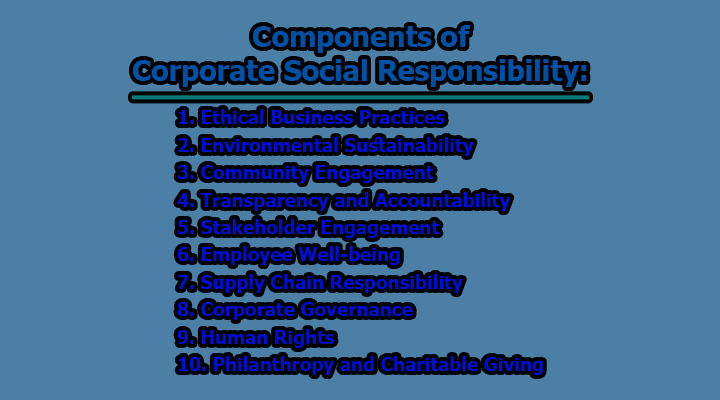Components of Corporate Social Responsibility:
Corporate Social Responsibility (CSR) is a concept that encourages businesses and organizations to consider the social and environmental impacts of their operations and to take steps to minimize any negative effects while actively contributing to the well-being of society. CSR is comprised of several key components, and these components can vary slightly depending on the source. Here are some of the necessary components of corporate social responsibility:
1. Ethical Business Practices: Ethical business practices are foundational to CSR. This involves conducting business in a manner that is honest, transparent, and fair both internally and externally. It means treating employees, customers, suppliers, and all stakeholders with respect and integrity. Ethical behavior in business includes not engaging in activities that harm others, society, or the environment (Carroll & Buchholtz, 2014).
Ethical practices are crucial for building trust and reputation in the marketplace. Violating ethical norms can result in damage to a company’s brand and financial losses. Ethical conduct often includes adhering to legal standards, but it goes beyond mere compliance to encompass behaviors that are socially and morally responsible.
2. Environmental Sustainability: Environmental sustainability is a key CSR component that focuses on minimizing the environmental impact of an organization’s operations. This includes efforts to reduce energy consumption, minimize waste, and decrease greenhouse gas emissions. Companies implement sustainable practices to protect the environment, conserve resources, and meet regulatory requirements (Dyllick & Hockerts, 2002).
Organizations that prioritize environmental sustainability might implement measures such as using renewable energy sources, adopting recycling programs, reducing water consumption, and investing in energy-efficient technologies. These efforts align with broader global goals of mitigating climate change and reducing ecological footprints.
3. Community Engagement: Community engagement is about actively participating in and supporting the communities in which a company operates. It involves corporate initiatives aimed at enhancing the well-being of local communities. These initiatives may include philanthropic activities, volunteer programs, and partnerships with local organizations to address community needs (Moon, 2004).
Engaging with the community not only enhances a company’s reputation but also fosters goodwill among customers and stakeholders. Companies often support local schools, charities, and social programs to contribute to community development and build positive relationships.
4. Transparency and Accountability: Transparency and accountability are essential components of CSR. Transparency entails openly communicating a company’s CSR efforts, policies, and outcomes. This includes sharing information about environmental impacts, social initiatives, and governance practices. Transparency is essential for building trust with stakeholders (Smith, 2003).
Accountability involves taking responsibility for the outcomes of CSR efforts. Companies should have mechanisms in place to track and report on their progress, and they should be prepared to address shortcomings or failures in their CSR initiatives. Accountability ensures that CSR commitments are not just rhetoric but lead to meaningful actions and results.
5. Stakeholder Engagement: Stakeholder engagement is a core aspect of CSR, involving interaction with various groups that have a stake in the company’s activities, including employees, customers, investors, and regulators. Effective stakeholder engagement seeks to understand and address their concerns and expectations (Freeman, 1984).
Engaging with stakeholders helps companies make informed decisions and build support for their CSR initiatives. It also enables companies to better respond to changing societal expectations and emerging issues. This component is about fostering a two-way dialogue between the organization and its stakeholders, recognizing that the interests of these groups may vary.
6. Employee Well-being: Employee well-being is a critical aspect of CSR. It involves ensuring the health, safety, and overall quality of life for employees. Companies committed to this aspect of CSR provide fair wages, safe working conditions, opportunities for personal and professional development, and work-life balance (Garriga & Melé, 2004).
Investing in employee well-being not only enhances the productivity and satisfaction of the workforce but also helps attract and retain talent. Companies that prioritize employee well-being often see reduced turnover rates and increased employee engagement.
7. Supply Chain Responsibility: Supply chain responsibility requires companies to extend their CSR commitments to their supply chains. This means monitoring and promoting ethical and sustainable practices among suppliers. It includes ensuring fair labor practices, ethical sourcing of materials, and adherence to human rights throughout the supply chain (Klassen & McLaughlin, 1996).
Companies that fail to address supply chain responsibility can face reputational risks and legal implications if unethical or unsustainable practices are discovered within their supply chains. This component encourages transparency and accountability across the entire value chain.
8. Corporate Governance: Corporate governance is a key component of CSR that focuses on the ethical and effective management of a company. It involves having an effective board of directors, ethical leadership, and transparent decision-making processes. Good corporate governance ensures that the organization operates in an accountable and responsible manner (Monks & Minow, 2008).
Effective corporate governance is crucial for building trust with investors, customers, and other stakeholders. It helps prevent unethical behavior, fraud, and mismanagement within the organization.
9. Human Rights: Respecting and upholding human rights is an integral part of CSR. Companies are expected to ensure the fair treatment of employees and avoid engaging in activities that violate human rights, such as child labor, discrimination, or unsafe working conditions. This component aligns with international human rights standards (United Nations Global Compact, 2011).
Violating human rights can result in significant legal and reputational risks for companies. Therefore, integrating human rights considerations into business operations is essential for ethical and responsible corporate behavior.
10. Philanthropy and Charitable Giving: While philanthropy is just one aspect of CSR, it involves donating funds, goods, or services to charitable causes and nonprofit organizations. Philanthropic activities are often aimed at addressing societal issues, such as poverty, education, healthcare, or disaster relief (Carroll, 1999).
Philanthropy allows companies to give back to society and demonstrate their commitment to social responsibility. It can also have positive public relations and marketing benefits.
In conclusion, CSR is not a one-size-fits-all concept, and the specific components and priorities may vary from one organization to another based on factors like industry, size, location, and stakeholder expectations. Furthermore, CSR is a continually evolving field, and new components and best practices may emerge over time as societal expectations and business practices change.
References:
- Carroll, A. B. (1999). Corporate social responsibility: Evolution of a definitional construct. Business & Society, 38(3), 268-295.
- Carroll, A. B., & Buchholtz, A. K. (2014). Business and society: Ethics, sustainability, and stakeholder management. Cengage Learning.
- Dyllick, T., & Hockerts, K. (2002). Beyond the business case for corporate sustainability. Business Strategy and the Environment, 11(2), 130-141.
- Moon, J. (2004). Government as a driver of corporate social responsibility: The UK in comparative perspective. Corporate Social Responsibility and Environmental Management, 11(1), 77-86.
- Smith, N. C. (2003). Corporate social responsibility: Whether or how? California Management Review, 45(4), 52-76.
- Freeman, R. E. (1984). Strategic management: A stakeholder approach. Pitman.
- Garriga, E., & Melé, D. (2004). Corporate social responsibility theories: Mapping the territory. Journal of Business Ethics, 53(1-2), 51-71.
- Klassen, R. D., & McLaughlin, C. P. (1996). The impact of environmental management on firm performance. Management Science, 42(8), 1199-1214.
- Monks, R. A. G., & Minow, N. (2008). Corporate governance. John Wiley & Sons.
- United Nations Global Compact. (2011). The Ten Principles of the UN Global Compact. Retrieved from https://www.unglobalcompact.org/what-is-gc/mission/principles

Library Lecturer at Nurul Amin Degree College










